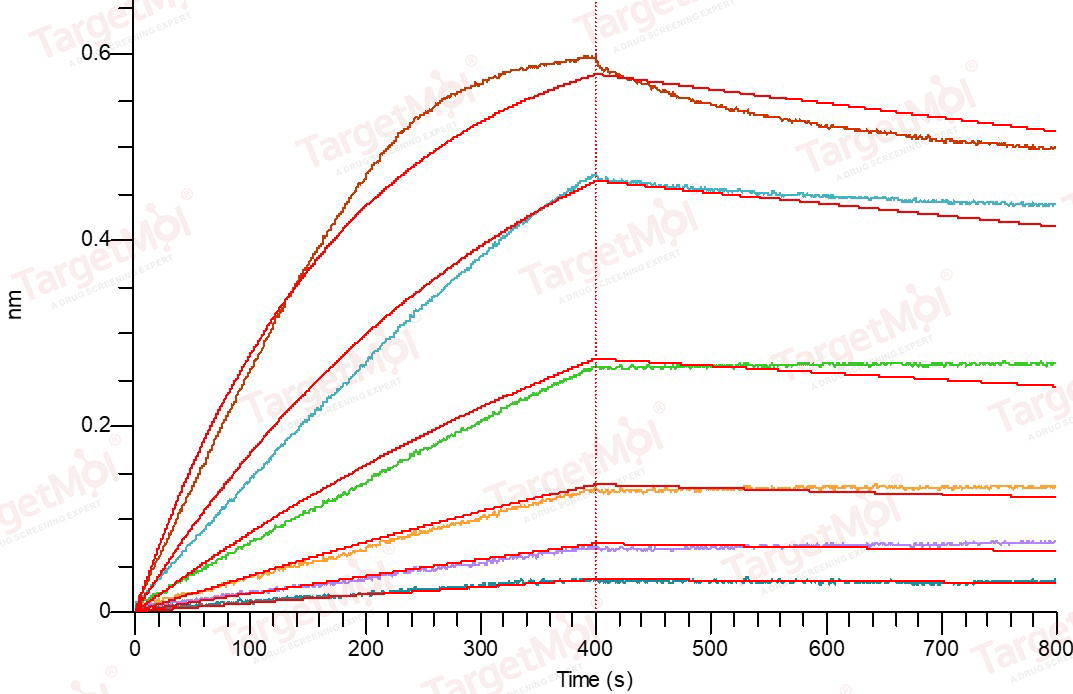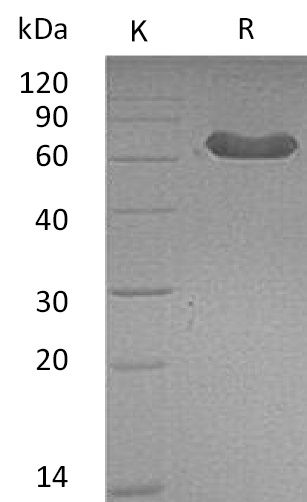- Remove All
 Your shopping cart is currently empty
Your shopping cart is currently empty
LTBR Protein, Mouse, Recombinant (hFc)
It is a single-pass type I membrane protein and contains 4 TNFR-Cys repeats. The protein is a member of the tumor necrosis factor (TNF) family of receptors. It is expressed on the surface of most cell types, including cells of epithelial and myeloid lineages, but not on T and B lymphocytes. The protein is the receptor for the heterotrimeric lymphotoxin containing LTA and LTB, and for TNFS14/LIGHT. It promotes apoptosis via TRAF3 and TRAF5 and may play a role in the development of lymphoid organs. The encoded protein and its ligand play a role in the development and organization of lymphoid tissue and transformed cells. Activation of the encoded protein can trigger apoptosis. Not only does the TNFRSF3 help trigger apoptosis, it can lead to the release of the cytokine interleukin 8. Overexpression of TNFRSF3 in Human Cells cells increases IL-8 promoter activity and leads to IL-8 release. TNFRSF3 is also essential for development and organization of the secondary lymphoid organs and chemokine release.

LTBR Protein, Mouse, Recombinant (hFc)
| Pack Size | Price | Availability | Quantity |
|---|---|---|---|
| 10 μg | $75 | In Stock | |
| 50 μg | $197 | 7-10 days | |
| 500 μg | $1,220 | 7-10 days | |
| 1 mg | $2,730 | 7-10 days |
Product Information
| Biological Activity | Loaded Mouse LTBR-Fc on Protein A Biosensor, can bind Human LIGHT-His with an affinity constant of 0.81 nM as determined in BLI assay. (Regularly tested)  |
| Description | It is a single-pass type I membrane protein and contains 4 TNFR-Cys repeats. The protein is a member of the tumor necrosis factor (TNF) family of receptors. It is expressed on the surface of most cell types, including cells of epithelial and myeloid lineages, but not on T and B lymphocytes. The protein is the receptor for the heterotrimeric lymphotoxin containing LTA and LTB, and for TNFS14/LIGHT. It promotes apoptosis via TRAF3 and TRAF5 and may play a role in the development of lymphoid organs. The encoded protein and its ligand play a role in the development and organization of lymphoid tissue and transformed cells. Activation of the encoded protein can trigger apoptosis. Not only does the TNFRSF3 help trigger apoptosis, it can lead to the release of the cytokine interleukin 8. Overexpression of TNFRSF3 in Human Cells cells increases IL-8 promoter activity and leads to IL-8 release. TNFRSF3 is also essential for development and organization of the secondary lymphoid organs and chemokine release. |
| Species | Mouse |
| Expression System | HEK293 Cells |
| Tag | C-hFc |
| Accession Number | P50284 |
| Synonyms | Tumor necrosis factor receptor superfamily member 3,Tnfrsf3,Tnfcr,Lymphotoxin-β receptor,Lymphotoxin-beta receptor,Ltbr |
| Amino Acid | Ser28-Pro218 |
| Construction | Ser28-Pro218 |
| Protein Purity | Greater than 95% as determined by reducing SDS-PAGE. (QC verified)  |
| Molecular Weight | 61 KDa (reducing condition) |
| Endotoxin | < 0.1 ng/µg (1 EU/µg) as determined by LAL test. |
| Formulation | Lyophilized from a solution filtered through a 0.22 μm filter, containing PBS, pH 7.4. |
| Reconstitution | Reconstitute the lyophilized protein in distilled water. The product concentration should not be less than 100 μg/ml. Before opening, centrifuge the tube to collect powder at the bottom. After adding the reconstitution buffer, avoid vortexing or pipetting for mixing. |
| Stability & Storage | Lyophilized powders can be stably stored for over 12 months, while liquid products can be stored for 6-12 months at -80°C. For reconstituted protein solutions, the solution can be stored at -20°C to -80°C for at least 3 months. Please avoid multiple freeze-thaw cycles and store products in aliquots. |
| Shipping | In general, Lyophilized powders are shipping with blue ice. Solutions are shipping with dry ice. |
| Research Background | It is a single-pass type I membrane protein and contains 4 TNFR-Cys repeats. The protein is a member of the tumor necrosis factor (TNF) family of receptors. It is expressed on the surface of most cell types, including cells of epithelial and myeloid lineages, but not on T and B lymphocytes. The protein is the receptor for the heterotrimeric lymphotoxin containing LTA and LTB, and for TNFS14/LIGHT. It promotes apoptosis via TRAF3 and TRAF5 and may play a role in the development of lymphoid organs. The encoded protein and its ligand play a role in the development and organization of lymphoid tissue and transformed cells. Activation of the encoded protein can trigger apoptosis. Not only does the TNFRSF3 help trigger apoptosis, it can lead to the release of the cytokine interleukin 8. Overexpression of TNFRSF3 in Human Cells cells increases IL-8 promoter activity and leads to IL-8 release. TNFRSF3 is also essential for development and organization of the secondary lymphoid organs and chemokine release. |
Dose Conversion
Calculator
Tech Support
Keywords

Copyright © 2015-2025 TargetMol Chemicals Inc. All Rights Reserved.


